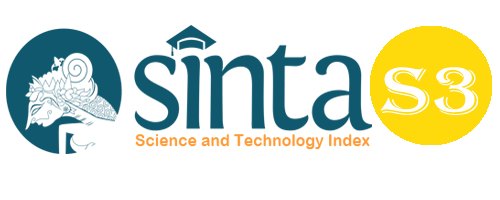The Financial Perspective Study on Tax Avoidance
Abstract
Practically, it is still found that there is a distinction of interest between government and taxpayers, where the government has an interest in collecting taxes as optimal as possible to be channeled in the public interest, while taxpayers try to pay tax as efficiently as possible for their individual benefits. This study employed a confirmatory descriptive approach with aims to find out wheter financial reasons urged taxpayers to do tax avoidance. The population in this study is the annual financial statements of manufacturing companies listed in Indonesia Stock Exchange. The data collected and processed using the ordinary least square approach. This study proposed that transfer pricing has no significant effect on tax avoidance, leverage has a significant effect on tax avoidance, profitability has a significant effect on tax avoidance, and sales growth has a significant effect on tax avoidance. While the result of the simultaneous test shows that the overall predictor has a significant effect on tax avoidance. The findings from this study are important inputs, especially for government tax recipients to pay more attention to the companies where profitability and sales growth are high, and when receivables shifts are more concentrated on receivables with related parties when compared to receivables from other parties, the such companies are tend to do tax efficiency by means of tax avoidance.
Keywords
Full Text:
PDFReferences
Adegbite, T. A., & Bojuwon, M. (2019). Corporate Tax Avoidance Practices: An Empirical Evidence from Nigerian Firms. Studia Universitatis Babes-Bolyai, 64(3), pp. 39-53.
Amidu, M., Coffie, W. & Acquah, P. (2019). Transfer Pricing, Earnings Management and Tax Avoidance of Firms in Ghana. Journal of Financial Crime, Vol. 26 No. 1, pp. 235-259.
Anonymous. (2015). Firm Age, Sales Growth, and Tax Aggressiveness: Focus on Small and Medium Enterprises (2015). . Washington: International Council for Small Business (ICSB).
Baginski, S.P., Bradshow, M.T. & Wahlen, J.M. (2018). Financial Reporting, Financial Statement Analysis, and Valuation: A Strategic Perspective. Cengage. Boston USA.
Bimo, I. D., Christianus, Y. P., & Susilandari, C. A. (2019). The Effect of Internal Control on Tax Avoidance: the Case of Indonesia. Journal of Economics and Development, Vol. 21 No. 2, pp. 131-143.
Calvin, S., & Sukartha, I.M. (2015). The Effect of Executive Characteristics, Audit Committee, Company Size, Leverage and Sales Growth on Tax Avoidance. Jurnal Akuntansi Universitas Udayana. 10 (1).
Clausing, K.A. (2003). Tax Motivated Transfer Pricing and US Intrafirm Trade. Journal of Public Economics. Vol. 87, No. 9/10, pp. 2207-2223.
Croft, J., & Houlder, V. (2017). Rangers Football Club Tax Avoidance Case Reaches Supreme Court. FT.Com, Retrieved from https://search.proquest.com.ezproxy.ugm.ac.id/trade-journals/rangers-football-club-tax-avoidance-case-reaches/docview/1902221812/se-2?accountid=13771
Davidson, W. (2020). Financial Statement Analysis: Basis for Management Advice. AICPA & CIMA, Wiley
Desai, M.A. & Dharmapala, D. (2006). Corporate Tax Avoidance and High-Powered Incentives. Journal of Financial Economics, Vol. 79, No. 1, pp. 145-179.
Gaaya, S., Lakhal, N. & Lakhal, F. (2017). Does Family Ownership Reduce Corporate Tax Avoidance? The Moderating Effect of Audit Quality. Managerial Auditing Journal, Vol. 32 No. 7, pp. 731-744.
Godfrey, J., Hodgson, A., Tarca, A., Hamilton J., & Holmes, S. (2010). Accounting theory (7th ed.). New York: John Wiley & Sons.
Gunaasih, S. A. P. P. (2021). The Profitability, Leverage, and Company Size of the IDX80 Index on Tax Avoidance in Indonesia Stock Exchange. Review of Integrative Business and Economics Research, 10, 106-113.
Gupta, S. and Lynch, D.P. (2015). The Effects of Changes in State Tax Enforcement on Corporate Income Tax Collections. The Journal of the American Taxation Association. Vol. 38 No. 1, pp. 125-143.
Hanlon, M. & Heitzmen, S. (2010). A Review of Tax Research. Journal of Accounting and Economics. September. 50, pp 127-178.
Hughes, P. (2006). Tax Planning for Businesses and Their Owners. Thorogood Professional Insights
Ichsani, S., & Susanti, N. (2019). The Effect of Firm Value, Leverage, Profitability and Company Size on Tax Avoidance in Companies Listed on Index LQ45 Period 2012-2016. Global Business & Management Research, 11(1), pp. 307–313.
Irianto, B. S., Sudibyo, Y. A., & Wafirli, A. (2017). The Influence of Profitability, Leverage, Firm Size and Capital Intensity Towards Tax Avoidance. International Journal of Accounting and Taxation, 5(2), 33–41.
Jost, H. K. (2018). Tax Avoidance, Tax Risk and The Cost of Debt in A Bank-Dominated Economy. Managerial Auditing Journal, 33(8), pp 683-699. doi: 10.1108/MAJ-12-2017-1734
Karayan, J.E., Swenson, C.W., & Neff, J.W. (2002). Strategic Corporate Tax Planning. John Wiley & Sons, Inc.
Kim, J. H., & Chae, C. I. (2017). The Study on The Effect and Determinants of Small and Medium Sized Entities Conducting Tax Avoidance. Journal of Applied Business Research, 33(2), pp. 375-390.
Lee, B.B., Dobiyanski, A. and Minton, S. (2015). Theories and Empirical Proxies for Corporate Tax Avoidance. Journal of Applied Business and Economics, Vol. 17 No. 3, pp. 21-34
Liu, L., Schmidt-Eisenlohr, T., & Guo, D. (2019). International Transfer Pricing and Tax Avoidance: Evidence from Linked Trade-Tax Statistics in the UK. Review of Economics & Statistics, pp. 1–45.
Marriner, K. (2017, Aug 23). HMRC Winning Majority of Tax Avoidance Cases. Fundweb, Retrieved from https://search.proquest.com.ezproxy.ugm.ac.id/magazines/hmrc-winning-majority-tax-avoidance-cases/docview/1931426498/se-2?accountid=13771
Martinelli, I., et al. (2019). Community Economic Development Prospect Based on Wakaf Funds. Budapest International Research and Critics Institute-Journal(BIRCI- Journal), 409-423.
Nugraha, N. B., & Meiranto, W. (2015). The Influence of Corporate Social Responsibility, Company Size, Profitability, Leverage and Capital Intensity on Tax Aggressiveness (Empirical Study on Non-Financial Companies Listed on the Indonesia Stock Exchange 2012-2013). Diponegoro Journal Of Accounting, 4, 1–14.
Panjalusman, P.A., Nugraha, E., & Setiawan, A. (2018). The Effect of Transfer Pricing on Tax Avoidance. Journal of Accounting and Finance Education. 6(2).
Rathke, A.A.T., Rezende, A.J. & Watrin, C. (2020). The Impact of Countries' Transfer Pricing Rules on Profit Shifting. Journal of Applied Accounting Research, Vol. 22 No. 1, pp. 22-49.
Richardson, G., Wang, B. and Zhang, X. (2016). Ownership Structure and Corporate Tax Avoidance: Evidence from Publicly Listed Private Firms In China. Journal of Contemporary Accounting & Economics, Vol. 12 No. 2, pp. 141-158.
Riguen, R., Salhi, B., & Jarboui, A. (2020). Do Women in Board Represent Less Corporate Tax Avoidance? A Moderation Analysis. The International Journal of Sociology and Social Policy, 40(1), pp. 114-132.
Robert, G. M. (2006, Oct 18). U.S. Indicts Actor Snipes in Tax-Avoidance Case. Wall Street Journal Retrieved from https://search.proquest.com.ezproxy.ugm.ac.id/newspapers/u-s-indicts-actor-snipes-tax-avoidance-case/docview/398990991/se-2?accountid=13771
Roska, V., Valcic, S. B., & Samodol, A. (2019). Tax Avoidance – Case Study In Croatia. Varazdin: Varazdin Development and Entrepreneurship Agency (VADEA). Retrieved from https:// conference-papers-proceedings/tax-avoidance-case-study-croatia/docview/2269008424/se-2?accountid=13771
Salaudeen, Y. M. (2017). Corporate Effective Tax Rates in the Financial Services Sector: Evidence from Nigeria. International Journal of Accounting and Taxation, 5(1), 68–88.
Sari, D., Utama, S., Fitriany, and Rahayu, N. (2020). Transfer Pricing Practices and Specific Anti-Avoidance Rules in Asian Developing Countries. International Journal of Emerging Markets, Vol. ahead-of-print No. ahead-of-print. https://doi: 10.1108/IJOEM-10-2018-0541
Sekaran, U., & Bougie, R. (2010). Research Methods for Business: A Skill Building Approach. (5th ed.). Haddington: John Wiley & Sons.
Sikka, P. & Willmott, H. (2010). The Dark Side of Transfer Pricing: Its Role in Tax Avoidance and Wealth Retentiveness. Critical Perspectives on Accounting, Vol. 21 No. 4, pp. 342-356.
Solilova, V. & Nerudova, D., (2018). Transfer Pricing in SMEs Critical Analysis and Practical Solutions. Springer.
Subramanyam, K.R. (2014). Financial statement analysis. 11th Ed. University of Southern, USA.
Susanti, M. (2017). Corporate Social Responsibility, Size and Tax Avoidance. International Journal of Economic Perspectives, 11(1), 1639-1650.
Susanti, A., & Firmansyah, A. (2018). Determinants of Transfer Pricing Decisions in Indonesia Manufacturing Companies. Jurnal Akuntansi dan Auditing Indonesia, 22(2), pp. 81-93.
Saunders, M., Lewis, P., and Thornhill, A. (2009). Research Methods for Business Students 5th ed, Pearson Education Limited.
Thailand: Govt Goes Ahead With Ex-PM's Tax Avoidance Case. (2018, Nov 09). Asia News Monitor Retrieved from https://search.proquest.com.ezproxy.ugm.ac.id/newspapers/thailand-govt-goes-ahead-with-ex-pms-tax/docview/2130811252/se-2?accountid=13771
Tila, D. (2015). Transfer pricing: A multistate tax issue. Journal of State Taxation, 34(1), pp. 25-30.
UK Tax Avoidance Cases Considered in Hong Kong Trust Case. (1999). Trusts & Trustees, 5(2), pp. 6-36.
Yusuf, D., et al. (2019). The Effect of Buy and Sell Financing (Murabahah), Profit Share Financing (Mudarabah), Equity Capital Financing (Musyarakah) and Non- Performing Financing Ratio on Profitability Level of Sharia Commercial Banks in North Sumatera. Britain International of Humanties and Social Sciences (BIoHS) Journal, 81-88.
DOI: https://doi.org/10.33258/birci.v4i3.2287
Article Metrics
Abstract view : 1731 timesPDF - 597 times
Refbacks
- There are currently no refbacks.

This work is licensed under a Creative Commons Attribution-ShareAlike 4.0 International License.

This work is licensed under a Creative Commons Attribution-ShareAlike 4.0 International License.

_.gif)

















_.gif)



